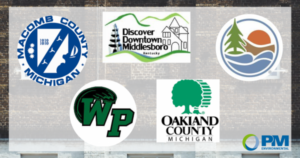PM Environmental Clients Awarded $1.96 Million in Brownfield Grants
Last week, the U.S. Environmental Protection Agency (EPA) awarded over $65.5 million to 155 communities across the United States through their Assessment, Revolving Loan Fund, and Cleanup Grant Programs.
The EPA’s program has assessed thousands of contaminated, vacant and blighted properties since it began in 1995, clearing the way for their reuse. The program has awarded $1.6 billion in brownfield grants over the last 25 years and supports revitalization efforts by funding environmental assessment, cleanup and job training activities.
PM’s National Managers for Brownfield and Economic Incentives, Jessica DeBone and John Hargraves, stressed the importance this funding has to communities. These awards show a mix of urban core and very rural settings with differing demographics and local challenges. The funding is vital to all areas to help economic and community development projects.
Each year, PM Environmental assists communities throughout Michigan and the mid-south with EPA brownfield grant applications. This year, five of PM’s clients were awarded funding that totaled a combined $1.96 million.
Macomb County, Michigan
Located in the southeast corner of Michigan, Macomb County has seen its share of economic prosperity and financial losses. The county saw rapid urbanization as families moved northward from the city of Detroit between 1920 and 1930 and prospered as the home to several automotive assembly plants for the Big 3 – the Ford Motor Company, Chrysler, and General Motors. At the onset of the 2008 recession, the county’s two largest employers, General Motors and Chrysler, as well as the city of Detroit, declared bankruptcy. The region lost over 44 thousand manufacturing-based jobs, leading to staggering unemployment rates, property foreclosures, building vacancies and plummeting property values and tax revenues.
Macomb County has made significant progress toward recovery in recent years, but challenges remain. One of those challenges is returning hundreds of brownfields sites, byproducts of former industrial and commercial facilities, to productive uses. The county collaborated with PM’s Brownfield and Economic Incentives Team to assist with the grant application. The team successfully secured a $300,000 hazardous substances and petroleum assessment grant for the county, which will be used to conduct assessment activities at eligible brownfield sites and facilitate redevelopment.
Oakland County, Michigan
Adjacent to Macomb County, Oakland County was among the first and hardest hit when the economy fell into a recession in 2008. The county, which has not recovered the 30,000 jobs it lost in the downturn, is home to more than 1,000 vacant, blighted and contaminated brownfield properties. Many of these brownfield sites sit on the county’s border with the city of Detroit and impact the high-minority populations that live outside the county’s jurisdiction.
Oakland County partnered with PM to assist with their grant application. PM successfully secured $600,000 in Coalition Assessment Grant funds to assess hazardous substances and petroleum contamination. Environmental assessments will be conducted at target areas outlined by the county, paving the way for significant redevelopment.
Ottawa County, Michigan
Ottawa County sits on Michigan’s west coast, nestled on the shores of Lake Michigan. For years, its land was mined for timber before manufacturing flourished. Like its sister counties on Michigan’s east coast, Ottawa suffered plant closures and lost jobs totaling almost 35% of the county’s workforce in the 2008 recession, leaving vacant and blighted brownfield properties behind. In recent years, the county has seen an increase in agricultural jobs and sales, ranking first and third in the state respectively, but the industry is threatened by the explosion in population, one that cannot be sustained by the existing economy, land uses, job opportunities and municipal budgets.
PM’s Brownfield and Economic Incentives Team collaborated with Ottawa County on a pro bono basis to assist with their grant application. The team successfully secured a $300,000 grant for the county that will help grow employment sectors outside of manufacturing by preserving agricultural land, redevelopment brownfields sites, and support population growth through affordable and attainable housing opportunities.
Discover Downtown Middlesboro & Bell County, Kentucky Coalition
The Bell County Brownfield Coalition (BCBC), consisting of Bell County, Kentucky, the city of Middlesboro, Kentucky, and the nonprofit Discover Downtown Middlesboro, sits in the southeastern corner of Kentucky. The area has had a strong reliance on the coal and textile industries, whose downfalls have since led to a steady decline in jobs and population for the area and an increase in vacant and blighted brownfield properties.
The BCBC partnered with PM to assist with its EPA Brownfield Assessment Grant application. PM successfully secured $500,000 in funding for the coalition to assess hazardous and petroleum substances at brownfield sites. Funds will cover costs associated with environmental assessments, paving the way for tourist-friendly redevelopment.
West Clay Elementary School, Clay County, Mississippi
The West Clay Elementary School was built in 1967 in an extremely rural area of Clay County, Mississippi. Nestled amongst farmland and forests, the school serves approximately 135 students. Currently, four condemned buildings reside on the school property, in close proximity to the elementary school’s playground, all in various stages of decay.
The school district collaborated with PM’s Brownfield and Economic Incentives Team to assist with their grant application. PM successfully secured $264,000 in grant funding to properly assess and demolish the vacant and blighted buildings on the school’s property. Plans for future reuse of the site include added greenspace for play, and the potential expansion of the school’s playground.
While they may be diverse in location, they all share a common need for revitalization and redevelopment. A great deal of thought, planning, and understanding of the needs of the community have gone into each of these plans to ensure the best possible outcomes.
News Details
Date
May 15, 2020

